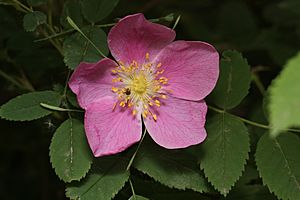Prickly wild rose facts for kids
Quick facts for kids Prickly wild rose |
|
|---|---|
 |
|
| Conservation status | |
| Scientific classification | |
| Genus: |
Rosa
|
| Species: |
acicularis
|
| Subspecies | |
|
|
| Synonyms | |
|
|
Rosa acicularis is a beautiful flowering plant. It belongs to the Rosaceae family, which also includes many other roses. People often call it the prickly wild rose, prickly rose, bristly rose, wild rose, or Arctic rose. This wild rose grows in many northern parts of Asia, Europe, and North America.
Contents
What is the Prickly Wild Rose?
The prickly wild rose is a deciduous shrub. This means it's a bushy plant that loses its leaves every autumn. It can grow to be about 1 to 3 meters (3 to 10 feet) tall.
Leaves and Flowers
The leaves of this rose are "pinnate." This means they have smaller leaflets arranged along a central stem, like a feather. Each leaf is usually 7 to 14 centimeters (about 3 to 5.5 inches) long and has three to seven leaflets. These leaflets are oval-shaped and have "serrate" edges, which means they are toothed, like a saw blade.
The flowers are usually pink, but sometimes they can be white. They are about 3.5 to 5 centimeters (about 1.5 to 2 inches) wide. After the flowers bloom, they produce red, pear-shaped or oval fruits called hips. These hips are about 10 to 15 millimeters (less than an inch) wide.
Where it Grows
You can find the prickly wild rose growing in many natural places. It likes thickets, which are dense groups of shrubs. It also grows along stream banks, on rocky bluffs, and on wooded hillsides.
Different Types of Prickly Wild Rose
Scientists study the "ploidy" of plants. This refers to how many sets of chromosomes a plant has. For the prickly wild rose, the number of chromosome sets can be different depending on where it grows. For example, in North America, some plants have four sets (tetraploid) or six sets (hexaploid). In places like Asia and Europe, some plants have eight sets (octoploid).
Prickly Wild Rose in North America
This rose is native to the northern Great Plains in North America. It is very special because it is the provincial flower of Alberta, a province in Canada. While it grows there, it's not as common as another type of rose called Rosa woodsii (Woods' rose) in the Canadian Prairie provinces or in the boreal forest of northern North America.
Uses of the Prickly Wild Rose
The rose hips, which are the fruits of the plant, are very useful. They stay on the plant even through the winter. These hips are known to be very high in vitamins A and C, which are good for your health!
Native Americans used different parts of this plant. They made tea and salad from the leaves. They also used the inner bark for traditional purposes. People have even made perfume from the beautiful flowers of this plant.
See also
- List of Rosa species
Images for kids






